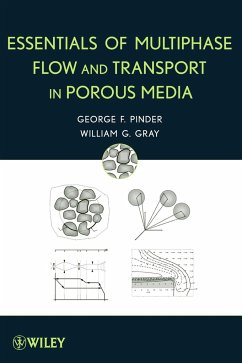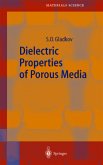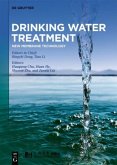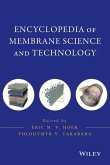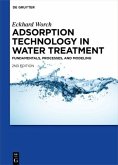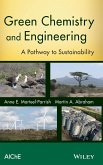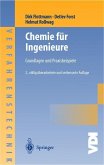- Gebundenes Buch
- Merkliste
- Auf die Merkliste
- Bewerten Bewerten
- Teilen
- Produkt teilen
- Produkterinnerung
- Produkterinnerung
This book looks at the mathematical physical rationale behind the equations that are currently used to describe the flow of fluid and transport of solutes in porous media. It presents a comprehensive approach to the development of appropriate equations without prior knowledge of continuum mechanics, mixture theory, or similar areas of expertise.
Andere Kunden interessierten sich auch für
![Dielectric Properties of Porous Media Dielectric Properties of Porous Media]() S.O. GladkovDielectric Properties of Porous Media77,99 €
S.O. GladkovDielectric Properties of Porous Media77,99 €![Porous Silicon Carbide and Gallium Nitride Porous Silicon Carbide and Gallium Nitride]() Randall M. FeenstraPorous Silicon Carbide and Gallium Nitride194,99 €
Randall M. FeenstraPorous Silicon Carbide and Gallium Nitride194,99 €![Drinking Water Treatment Drinking Water Treatment]() Drinking Water Treatment169,95 €
Drinking Water Treatment169,95 €![Encyclopedia of Membrane Science and Technology, 3 Volume Set Encyclopedia of Membrane Science and Technology, 3 Volume Set]() Encyclopedia of Membrane Science and Technology, 3 Volume Set1.082,99 €
Encyclopedia of Membrane Science and Technology, 3 Volume Set1.082,99 €![Adsorption Technology in Water Treatment Adsorption Technology in Water Treatment]() Eckhard WorchAdsorption Technology in Water Treatment159,95 €
Eckhard WorchAdsorption Technology in Water Treatment159,95 €![Green Chemistry and Engineering Green Chemistry and Engineering]() Martin A. AbrahamGreen Chemistry and Engineering99,99 €
Martin A. AbrahamGreen Chemistry and Engineering99,99 €![Chemie für Ingenieure Chemie für Ingenieure]() Dirk FlottmannChemie für Ingenieure74,99 €
Dirk FlottmannChemie für Ingenieure74,99 €-
-
-
This book looks at the mathematical physical rationale behind the equations that are currently used to describe the flow of fluid and transport of solutes in porous media. It presents a comprehensive approach to the development of appropriate equations without prior knowledge of continuum mechanics, mixture theory, or similar areas of expertise.
Produktdetails
- Produktdetails
- Verlag: Wiley & Sons
- 1. Auflage
- Seitenzahl: 272
- Erscheinungstermin: 1. August 2008
- Englisch
- Abmessung: 260mm x 183mm x 19mm
- Gewicht: 625g
- ISBN-13: 9780470317624
- ISBN-10: 0470317620
- Artikelnr.: 23427834
- Herstellerkennzeichnung
- Libri GmbH
- Europaallee 1
- 36244 Bad Hersfeld
- gpsr@libri.de
- Verlag: Wiley & Sons
- 1. Auflage
- Seitenzahl: 272
- Erscheinungstermin: 1. August 2008
- Englisch
- Abmessung: 260mm x 183mm x 19mm
- Gewicht: 625g
- ISBN-13: 9780470317624
- ISBN-10: 0470317620
- Artikelnr.: 23427834
- Herstellerkennzeichnung
- Libri GmbH
- Europaallee 1
- 36244 Bad Hersfeld
- gpsr@libri.de
George F. Pinder, PHD, is the Director of the Research Center for Groundwater Remediation Design and also a Professor of Civil and Environmental Engineering, Mathematics and Statistics, and Computer Science at the University of Vermont. He has served on the editorial board of numerous journals including the International Journal for Numerical Methods in Fluids. He has published extensively in the fields of groundwater flow and transport modeling and has written on the use of such models in combination with optimization methods in addressing problems of environmental optimal design. William G. Gray, PHD, is a Professor of Environmental Sciences and Engineering at the University of North Carolina at Chapel Hill. He has over thirty years of research and teaching experience in environmental modeling and the physics of flow in porous media. He has published widely on various aspects of environmental modeling and simulation and has served as editor and on the editorial boards of leading journals in his field. He is a Fellow of the American Geophysical Union.
1. Setting the Stage.
1.1 Introduction.
1.2 Phases and Porousmedia.
1.3 Grain and Pore Size Distributions.
1.4 The Concept of Saturation.
1.5 The Concept of Pressure.
1.6 Surface Tension Considerations.
1.7 Concept of Concentration.
1.8 Summary.
1.9 Exercises.
2. Mass Conservation Equations.
2.1 Introduction.
2.2 Microscalemass Conservation.
2.3 Integral Forms Ofmass Conservation.
2.4 Integral Theorems.
2.4.1 Divergence Theorem.
2.4.2 Transport Theorem.
2.5 Point Forms Ofmass Conservation.
2.6 Themacroscale Perspective.
2.6.1 The Representative Elementary Volume.
2.6.2 Global and Local Coordinate Systems.
2.6.3 Macroscopic Variables.
2.6.4 Definitions Of Macroscale Quantities.
2.6.5 Summary Of Macroscale Quantities.
2.7 The Averaging Theorems.
2.7.1 Spatial Averaging Theorem.
2.7.2 Temporal Averaging Theorem.
2.8 Macroscalemass Conservation.
2.8.1 Macroscale Point Forms.
2.8.2 Integral Forms.
2.9 Applications.
2.9.1 Integral Analysis.
2.9.2 Point Analysis.
2.10 Summary.
2.11 Exercises.
3. Flow Equations.
3.1 Introduction.
3.2 Darcy'S Experiments.
3.3 Fluid Properties.
3.4 Equations of State for Fluids.
3.4.1 Mass Fraction.
3.4.2 Mass Density and Pressure.
3.4.3 Fluid Viscosity.
3.5 Hydraulic Potential.
3.5.1 Hydrostatic Force and Hydraulic Head.
3.5.2 Derivatives of Hydraulic Head.
3.6 Single Phase Fluid Flow.
3.6.1 Darcy'S Law.
3.6.2 Hydraulic Conductivity and Permeability.
3.6.3 Derivation of Groundwater Flow Equation.
3.6.4 Recapitulation of the Derivation.
3.6.5 Initial and Boundary Conditions.
3.6.6 Two-Dimensional Flow.
3.7 Two-Phase Immiscible Flow.
3.7.1 Derivation of Flowequations.
3.7.2 Observations on the Pc - Sw Relationship.
3.7.3 Formulas for The Pc - Sw Relationship.
3.7.4 Observations of the Kà Rel - Sw Relationship.
3.7.5 Formulas for the Kà Rel - Sw Relation.
3.7.6 Special Cases of Multiphase Flow.
3.8 The Buckley-Leverett Analysis.
3.8.1 Fractional Flow.
3.8.2 Derivation of the Buckley-Leverett Equation.
3.8.3 Solution of the Buckley-Leverett Equation.
3.9 Summary.
3.10 Exercises.
4. Mass Transport Equations.
4.1 Introduction.
4.2 Velocity in the Species Transport Equations.
4.2.1 Direct Approach.
4.2.2 Rigorous Approach.
4.2.3 Distribution Approach.
4.2.4 Summary.
4.3 Closure Relations for the Dispersion Vector.
4.4 Chemical Reaction Rates.
4.5 Interphase Transfer Terms.
4.5.1 Kinetic Formulation.
4.5.2 Equilibriumformulation.
4.5.3 Summary: Kinetic Vs. Equilibrium Formulations.
4.6 Initial and Boundary Conditions.
4.7 Conclusion.
4.8 Exercises.
5. Simulation.
5.1 1-D Simulation of Air-Water Flow.
5.1.1 Drainage in a Homogeneous Soil.
5.1.2 Drainage in a Heterogeneous Soil.
5.1.3 Imbibition in Homogeneous Soil.
5.2 1-D Simulation of Dnapl-Water Flow.
5.2.1 Primary Dnapl Imbibition In Homogeneous Soil.
5.2.2 Density Effect.
5.2.3 Dnapl Drainage in Homogeneous Soil.
5.2.4 Secondary Imbibition of Dnapl in Homogeneous Soil.
5.2.5 Secondary Drainage in Homogeneous Soil.
5.2.6 Primary Imbibition in Heterogeneous Soil.
5.3 2-D Simulation of Dnapl-Water Flow.
5.3.1 Dnapl Descent into a Water-Saturated Reservoir.
5.4 Simulation Of Multiphase Flow And Transport.
5.4.1 1-D Two-Phase Flow and Transport.
5.4.2 2-D Two-Phase Flow and Transport.
5.5 2-D Single-Phase Flow and Transport.
5.5.1 Base-Case.
5.5.2 Effect of Inflow.
5.5.3 Impactofwell Discharge.
5.5.4 Effect of Adsorption.
5.5.5 Effect of a Low Transmissivity Region.
5.5.6 Effect of a High Transmissivity Region.
5.5.7 Effect of Rate of Reaction.
5.6 3-D Single-Phase Flow and Transport.
5.7 2-D Three-Phase Flow.
5.8 Summary.
6. Select Symbols.
1.1 Introduction.
1.2 Phases and Porousmedia.
1.3 Grain and Pore Size Distributions.
1.4 The Concept of Saturation.
1.5 The Concept of Pressure.
1.6 Surface Tension Considerations.
1.7 Concept of Concentration.
1.8 Summary.
1.9 Exercises.
2. Mass Conservation Equations.
2.1 Introduction.
2.2 Microscalemass Conservation.
2.3 Integral Forms Ofmass Conservation.
2.4 Integral Theorems.
2.4.1 Divergence Theorem.
2.4.2 Transport Theorem.
2.5 Point Forms Ofmass Conservation.
2.6 Themacroscale Perspective.
2.6.1 The Representative Elementary Volume.
2.6.2 Global and Local Coordinate Systems.
2.6.3 Macroscopic Variables.
2.6.4 Definitions Of Macroscale Quantities.
2.6.5 Summary Of Macroscale Quantities.
2.7 The Averaging Theorems.
2.7.1 Spatial Averaging Theorem.
2.7.2 Temporal Averaging Theorem.
2.8 Macroscalemass Conservation.
2.8.1 Macroscale Point Forms.
2.8.2 Integral Forms.
2.9 Applications.
2.9.1 Integral Analysis.
2.9.2 Point Analysis.
2.10 Summary.
2.11 Exercises.
3. Flow Equations.
3.1 Introduction.
3.2 Darcy'S Experiments.
3.3 Fluid Properties.
3.4 Equations of State for Fluids.
3.4.1 Mass Fraction.
3.4.2 Mass Density and Pressure.
3.4.3 Fluid Viscosity.
3.5 Hydraulic Potential.
3.5.1 Hydrostatic Force and Hydraulic Head.
3.5.2 Derivatives of Hydraulic Head.
3.6 Single Phase Fluid Flow.
3.6.1 Darcy'S Law.
3.6.2 Hydraulic Conductivity and Permeability.
3.6.3 Derivation of Groundwater Flow Equation.
3.6.4 Recapitulation of the Derivation.
3.6.5 Initial and Boundary Conditions.
3.6.6 Two-Dimensional Flow.
3.7 Two-Phase Immiscible Flow.
3.7.1 Derivation of Flowequations.
3.7.2 Observations on the Pc - Sw Relationship.
3.7.3 Formulas for The Pc - Sw Relationship.
3.7.4 Observations of the Kà Rel - Sw Relationship.
3.7.5 Formulas for the Kà Rel - Sw Relation.
3.7.6 Special Cases of Multiphase Flow.
3.8 The Buckley-Leverett Analysis.
3.8.1 Fractional Flow.
3.8.2 Derivation of the Buckley-Leverett Equation.
3.8.3 Solution of the Buckley-Leverett Equation.
3.9 Summary.
3.10 Exercises.
4. Mass Transport Equations.
4.1 Introduction.
4.2 Velocity in the Species Transport Equations.
4.2.1 Direct Approach.
4.2.2 Rigorous Approach.
4.2.3 Distribution Approach.
4.2.4 Summary.
4.3 Closure Relations for the Dispersion Vector.
4.4 Chemical Reaction Rates.
4.5 Interphase Transfer Terms.
4.5.1 Kinetic Formulation.
4.5.2 Equilibriumformulation.
4.5.3 Summary: Kinetic Vs. Equilibrium Formulations.
4.6 Initial and Boundary Conditions.
4.7 Conclusion.
4.8 Exercises.
5. Simulation.
5.1 1-D Simulation of Air-Water Flow.
5.1.1 Drainage in a Homogeneous Soil.
5.1.2 Drainage in a Heterogeneous Soil.
5.1.3 Imbibition in Homogeneous Soil.
5.2 1-D Simulation of Dnapl-Water Flow.
5.2.1 Primary Dnapl Imbibition In Homogeneous Soil.
5.2.2 Density Effect.
5.2.3 Dnapl Drainage in Homogeneous Soil.
5.2.4 Secondary Imbibition of Dnapl in Homogeneous Soil.
5.2.5 Secondary Drainage in Homogeneous Soil.
5.2.6 Primary Imbibition in Heterogeneous Soil.
5.3 2-D Simulation of Dnapl-Water Flow.
5.3.1 Dnapl Descent into a Water-Saturated Reservoir.
5.4 Simulation Of Multiphase Flow And Transport.
5.4.1 1-D Two-Phase Flow and Transport.
5.4.2 2-D Two-Phase Flow and Transport.
5.5 2-D Single-Phase Flow and Transport.
5.5.1 Base-Case.
5.5.2 Effect of Inflow.
5.5.3 Impactofwell Discharge.
5.5.4 Effect of Adsorption.
5.5.5 Effect of a Low Transmissivity Region.
5.5.6 Effect of a High Transmissivity Region.
5.5.7 Effect of Rate of Reaction.
5.6 3-D Single-Phase Flow and Transport.
5.7 2-D Three-Phase Flow.
5.8 Summary.
6. Select Symbols.
1. Setting the Stage.
1.1 Introduction.
1.2 Phases and Porousmedia.
1.3 Grain and Pore Size Distributions.
1.4 The Concept of Saturation.
1.5 The Concept of Pressure.
1.6 Surface Tension Considerations.
1.7 Concept of Concentration.
1.8 Summary.
1.9 Exercises.
2. Mass Conservation Equations.
2.1 Introduction.
2.2 Microscalemass Conservation.
2.3 Integral Forms Ofmass Conservation.
2.4 Integral Theorems.
2.4.1 Divergence Theorem.
2.4.2 Transport Theorem.
2.5 Point Forms Ofmass Conservation.
2.6 Themacroscale Perspective.
2.6.1 The Representative Elementary Volume.
2.6.2 Global and Local Coordinate Systems.
2.6.3 Macroscopic Variables.
2.6.4 Definitions Of Macroscale Quantities.
2.6.5 Summary Of Macroscale Quantities.
2.7 The Averaging Theorems.
2.7.1 Spatial Averaging Theorem.
2.7.2 Temporal Averaging Theorem.
2.8 Macroscalemass Conservation.
2.8.1 Macroscale Point Forms.
2.8.2 Integral Forms.
2.9 Applications.
2.9.1 Integral Analysis.
2.9.2 Point Analysis.
2.10 Summary.
2.11 Exercises.
3. Flow Equations.
3.1 Introduction.
3.2 Darcy'S Experiments.
3.3 Fluid Properties.
3.4 Equations of State for Fluids.
3.4.1 Mass Fraction.
3.4.2 Mass Density and Pressure.
3.4.3 Fluid Viscosity.
3.5 Hydraulic Potential.
3.5.1 Hydrostatic Force and Hydraulic Head.
3.5.2 Derivatives of Hydraulic Head.
3.6 Single Phase Fluid Flow.
3.6.1 Darcy'S Law.
3.6.2 Hydraulic Conductivity and Permeability.
3.6.3 Derivation of Groundwater Flow Equation.
3.6.4 Recapitulation of the Derivation.
3.6.5 Initial and Boundary Conditions.
3.6.6 Two-Dimensional Flow.
3.7 Two-Phase Immiscible Flow.
3.7.1 Derivation of Flowequations.
3.7.2 Observations on the Pc - Sw Relationship.
3.7.3 Formulas for The Pc - Sw Relationship.
3.7.4 Observations of the Kà Rel - Sw Relationship.
3.7.5 Formulas for the Kà Rel - Sw Relation.
3.7.6 Special Cases of Multiphase Flow.
3.8 The Buckley-Leverett Analysis.
3.8.1 Fractional Flow.
3.8.2 Derivation of the Buckley-Leverett Equation.
3.8.3 Solution of the Buckley-Leverett Equation.
3.9 Summary.
3.10 Exercises.
4. Mass Transport Equations.
4.1 Introduction.
4.2 Velocity in the Species Transport Equations.
4.2.1 Direct Approach.
4.2.2 Rigorous Approach.
4.2.3 Distribution Approach.
4.2.4 Summary.
4.3 Closure Relations for the Dispersion Vector.
4.4 Chemical Reaction Rates.
4.5 Interphase Transfer Terms.
4.5.1 Kinetic Formulation.
4.5.2 Equilibriumformulation.
4.5.3 Summary: Kinetic Vs. Equilibrium Formulations.
4.6 Initial and Boundary Conditions.
4.7 Conclusion.
4.8 Exercises.
5. Simulation.
5.1 1-D Simulation of Air-Water Flow.
5.1.1 Drainage in a Homogeneous Soil.
5.1.2 Drainage in a Heterogeneous Soil.
5.1.3 Imbibition in Homogeneous Soil.
5.2 1-D Simulation of Dnapl-Water Flow.
5.2.1 Primary Dnapl Imbibition In Homogeneous Soil.
5.2.2 Density Effect.
5.2.3 Dnapl Drainage in Homogeneous Soil.
5.2.4 Secondary Imbibition of Dnapl in Homogeneous Soil.
5.2.5 Secondary Drainage in Homogeneous Soil.
5.2.6 Primary Imbibition in Heterogeneous Soil.
5.3 2-D Simulation of Dnapl-Water Flow.
5.3.1 Dnapl Descent into a Water-Saturated Reservoir.
5.4 Simulation Of Multiphase Flow And Transport.
5.4.1 1-D Two-Phase Flow and Transport.
5.4.2 2-D Two-Phase Flow and Transport.
5.5 2-D Single-Phase Flow and Transport.
5.5.1 Base-Case.
5.5.2 Effect of Inflow.
5.5.3 Impactofwell Discharge.
5.5.4 Effect of Adsorption.
5.5.5 Effect of a Low Transmissivity Region.
5.5.6 Effect of a High Transmissivity Region.
5.5.7 Effect of Rate of Reaction.
5.6 3-D Single-Phase Flow and Transport.
5.7 2-D Three-Phase Flow.
5.8 Summary.
6. Select Symbols.
1.1 Introduction.
1.2 Phases and Porousmedia.
1.3 Grain and Pore Size Distributions.
1.4 The Concept of Saturation.
1.5 The Concept of Pressure.
1.6 Surface Tension Considerations.
1.7 Concept of Concentration.
1.8 Summary.
1.9 Exercises.
2. Mass Conservation Equations.
2.1 Introduction.
2.2 Microscalemass Conservation.
2.3 Integral Forms Ofmass Conservation.
2.4 Integral Theorems.
2.4.1 Divergence Theorem.
2.4.2 Transport Theorem.
2.5 Point Forms Ofmass Conservation.
2.6 Themacroscale Perspective.
2.6.1 The Representative Elementary Volume.
2.6.2 Global and Local Coordinate Systems.
2.6.3 Macroscopic Variables.
2.6.4 Definitions Of Macroscale Quantities.
2.6.5 Summary Of Macroscale Quantities.
2.7 The Averaging Theorems.
2.7.1 Spatial Averaging Theorem.
2.7.2 Temporal Averaging Theorem.
2.8 Macroscalemass Conservation.
2.8.1 Macroscale Point Forms.
2.8.2 Integral Forms.
2.9 Applications.
2.9.1 Integral Analysis.
2.9.2 Point Analysis.
2.10 Summary.
2.11 Exercises.
3. Flow Equations.
3.1 Introduction.
3.2 Darcy'S Experiments.
3.3 Fluid Properties.
3.4 Equations of State for Fluids.
3.4.1 Mass Fraction.
3.4.2 Mass Density and Pressure.
3.4.3 Fluid Viscosity.
3.5 Hydraulic Potential.
3.5.1 Hydrostatic Force and Hydraulic Head.
3.5.2 Derivatives of Hydraulic Head.
3.6 Single Phase Fluid Flow.
3.6.1 Darcy'S Law.
3.6.2 Hydraulic Conductivity and Permeability.
3.6.3 Derivation of Groundwater Flow Equation.
3.6.4 Recapitulation of the Derivation.
3.6.5 Initial and Boundary Conditions.
3.6.6 Two-Dimensional Flow.
3.7 Two-Phase Immiscible Flow.
3.7.1 Derivation of Flowequations.
3.7.2 Observations on the Pc - Sw Relationship.
3.7.3 Formulas for The Pc - Sw Relationship.
3.7.4 Observations of the Kà Rel - Sw Relationship.
3.7.5 Formulas for the Kà Rel - Sw Relation.
3.7.6 Special Cases of Multiphase Flow.
3.8 The Buckley-Leverett Analysis.
3.8.1 Fractional Flow.
3.8.2 Derivation of the Buckley-Leverett Equation.
3.8.3 Solution of the Buckley-Leverett Equation.
3.9 Summary.
3.10 Exercises.
4. Mass Transport Equations.
4.1 Introduction.
4.2 Velocity in the Species Transport Equations.
4.2.1 Direct Approach.
4.2.2 Rigorous Approach.
4.2.3 Distribution Approach.
4.2.4 Summary.
4.3 Closure Relations for the Dispersion Vector.
4.4 Chemical Reaction Rates.
4.5 Interphase Transfer Terms.
4.5.1 Kinetic Formulation.
4.5.2 Equilibriumformulation.
4.5.3 Summary: Kinetic Vs. Equilibrium Formulations.
4.6 Initial and Boundary Conditions.
4.7 Conclusion.
4.8 Exercises.
5. Simulation.
5.1 1-D Simulation of Air-Water Flow.
5.1.1 Drainage in a Homogeneous Soil.
5.1.2 Drainage in a Heterogeneous Soil.
5.1.3 Imbibition in Homogeneous Soil.
5.2 1-D Simulation of Dnapl-Water Flow.
5.2.1 Primary Dnapl Imbibition In Homogeneous Soil.
5.2.2 Density Effect.
5.2.3 Dnapl Drainage in Homogeneous Soil.
5.2.4 Secondary Imbibition of Dnapl in Homogeneous Soil.
5.2.5 Secondary Drainage in Homogeneous Soil.
5.2.6 Primary Imbibition in Heterogeneous Soil.
5.3 2-D Simulation of Dnapl-Water Flow.
5.3.1 Dnapl Descent into a Water-Saturated Reservoir.
5.4 Simulation Of Multiphase Flow And Transport.
5.4.1 1-D Two-Phase Flow and Transport.
5.4.2 2-D Two-Phase Flow and Transport.
5.5 2-D Single-Phase Flow and Transport.
5.5.1 Base-Case.
5.5.2 Effect of Inflow.
5.5.3 Impactofwell Discharge.
5.5.4 Effect of Adsorption.
5.5.5 Effect of a Low Transmissivity Region.
5.5.6 Effect of a High Transmissivity Region.
5.5.7 Effect of Rate of Reaction.
5.6 3-D Single-Phase Flow and Transport.
5.7 2-D Three-Phase Flow.
5.8 Summary.
6. Select Symbols.

